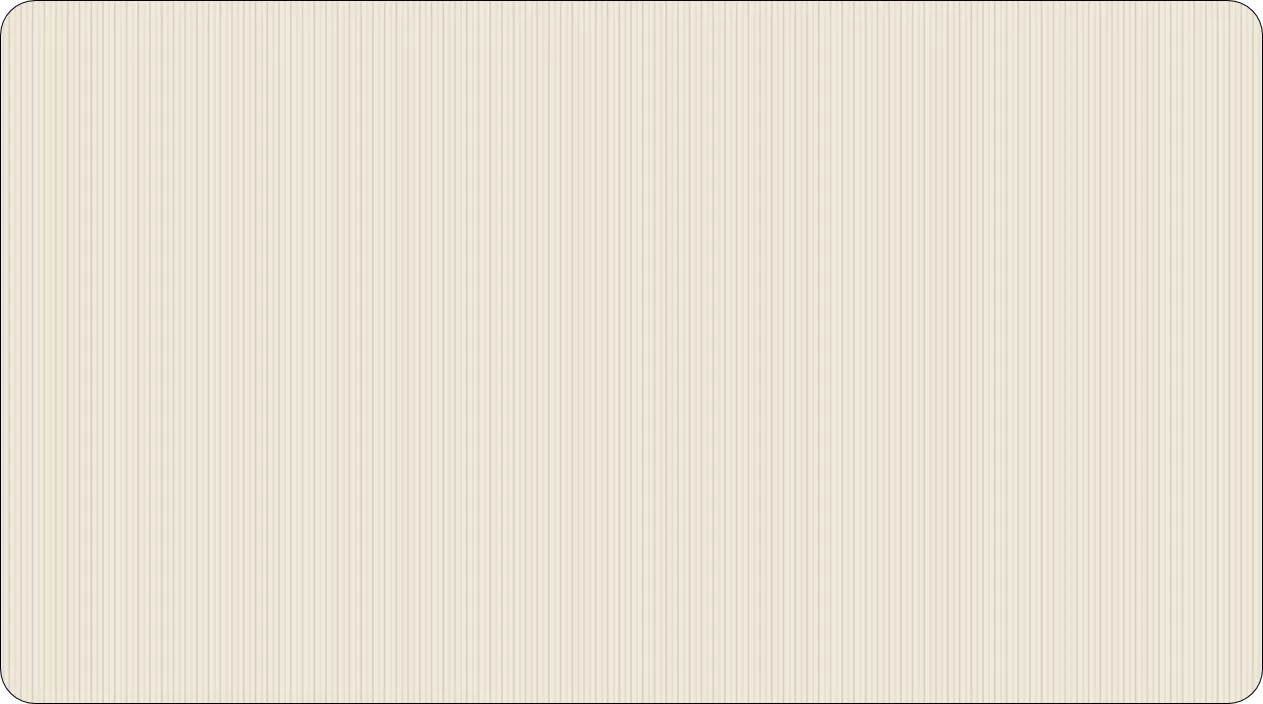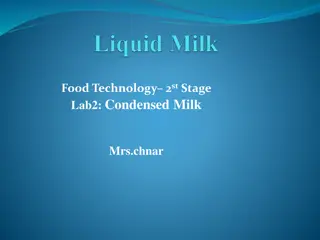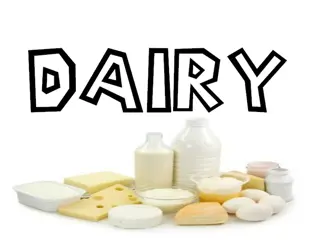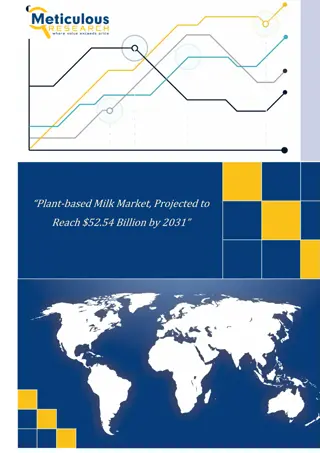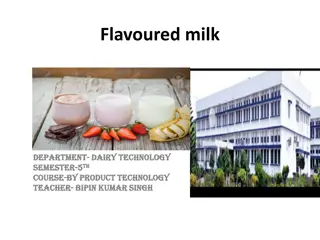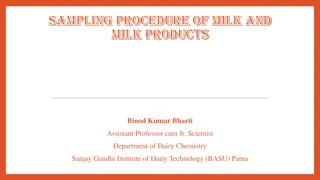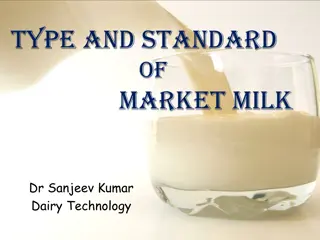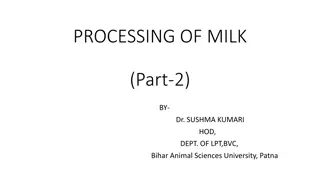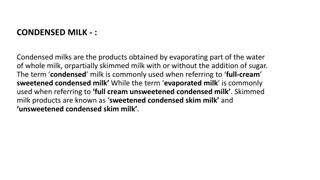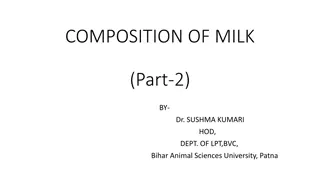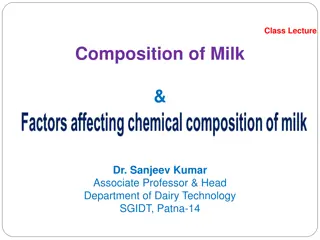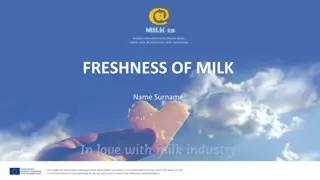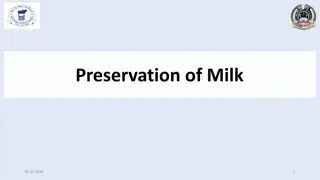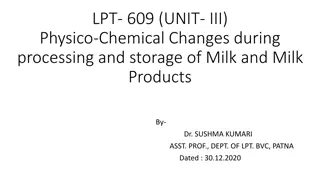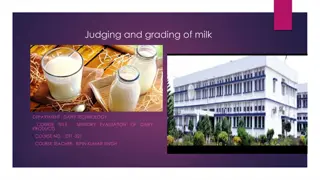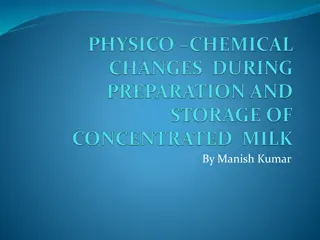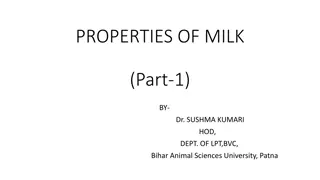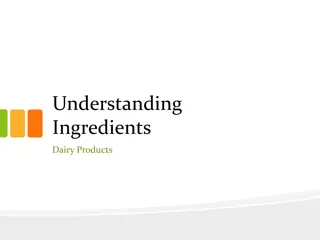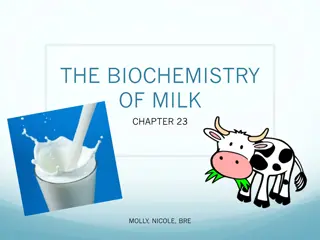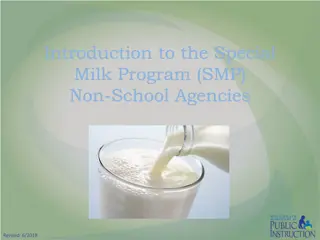Understanding Milk Standardization: Methods and Objectives
Milk standardization is the process of adjusting milk constituents to meet legal requirements and ensure product uniformity. This involves reducing butterfat content through addition of skim milk or removal of cream. The primary objectives include legal compliance, uniform product quality, and efficient production. Calculation methods like Pearson's Square are used to determine ingredient proportions for standardized milk or cream. Numerical examples demonstrate practical applications of standardization processes.
Download Presentation

Please find below an Image/Link to download the presentation.
The content on the website is provided AS IS for your information and personal use only. It may not be sold, licensed, or shared on other websites without obtaining consent from the author. Download presentation by click this link. If you encounter any issues during the download, it is possible that the publisher has removed the file from their server.
E N D
Presentation Transcript
STANDARDIZATION OF MILK Dr Sanjeev Kumar Associate Professor & Head Dairy Technology, SGIDT,Patna (BASU, Patna)
Standardization: Defined as the adjustment of one or more of the milk constituents to meet the legal requirement or nominated level. In market milk industry, normally involves reducing the butterfat content by addition of skim milk or Through the removal of cream
Objectives To comply with the legal requirements for particular milk/dairy products. To provide the consumer with a uniform product. To ensure economics in production. Addition of skim milk increases the volume of milk available for sale and Removal of cream allows the production of other value added dairy products s/a table cream, butter or other Dairy products
Methods of Calculation For standardization of milk or cream for product manufacture, usually the proportions of the various ingredients of known composition to be mixed, -- required to be estimated. Done by: Pearson's Square method Algebraic equations
Pearsons square Method Draw a square and place in the Centre of it the desired fat percentage. Place at the left hand corners of the square, the fat percentage of the materials to be mixed. Next, subtract the number in the Centre from the larger number at the left hand side of the square and place the remainder at the diagonally opposite right hand corners. The number on the right hand side now represents the number of parts of each of the original materials that must be blended to have the desired fat content in resultant mix The number at the upper right corner refers to the parts of material whose fat test was placed at the upper left corner. The number at the lower right corner refers to the parts of material whose fat test was placed at the lower left corner. If the numbers on the right are added, the sum obtained will represent the parts of the finished product.
Numericals Examples Problem 1 600 kg of cow milk testing 4% fat is to be standardized to toned milk by removing 33% fat cream. Calculate the amount of toned milk Examples Problem 2 1000 kg of double toned milk (DTM) is to be prepared by mixing whole milk, testing 5.5% fat and skim milk testing 0.2% fat. Calculate the amount of whole milk and skim milk required.
Algebraic equations Algebraic equations Algebraic Equations We have to know the composition of the products to be mixed, the final product and the quantity of any one product. Mass balance equations are formed and solved The formula for determining the quantities of skim milk and raw milk on this basis as follows: Skim milk (kg) = kg standard milk required x (% fat in raw milk - % fat in standard milk) Whole milk (kg) = kg standard milk required x (% fat in standard milk - % fat in skim milk)
Conti--- Problem Prepare 500 kg milk testing 3.0% fat and 8.5% SNF. You are provided with whole milk having 5.0% fat and 9.0% SNF and skim milk powder having 0.5% fat and 96.0% SNF. Solution: Let the quantity of the whole milk = X kg Quantity of SMP = Y kg Quantity of water = Z kg Fat equation: SNF equation: X + Y + Z = 500
Methods of Standardization Batch standardization Process most commonly used in the dairies The demerits of batch standardization -- the time taken for agitation, testing and final mixing. Continuous standardization Employs an inline sampler in association with a testing device, which samples, measures and displays the fat content every 20 seconds. Automatic standardization An extension of the continuous process. The separator is replaced by a microprocessor/controller unit linked to the sampler/tester system The merits of this automatic process are time and labour savings and ensure more accurate standardization than other methods
Conti--- Tri-Process Machine Tri-process machine - designed to clarify, separate, standardize milk in a single unit. The general construction -- similar to that of standard cream separator. The tri-process separator --- external valves in the discharge lines of cream and skim milk A precise needle valve is fixed in the outlet for cream, which controls the cream flow rate There is a bypass line connected from the cream discharge line to the skim milk discharge line.

 undefined
undefined







